Please note: Use Hearing Protection ended on 3 January 2022. To find out what exhibitions and activities are open today, visit our What’s On section.
Factory Records, the iconic independent record label and cultural catalyst based in Manchester, was a forward looking organisation that wanted to carve something new out of Manchester’s industrial past. The label’s partners included the record producer Martin Hannett, who was a champion of innovative sound equipment and someone who experimented with technology in the studio. Our current exhibition Use Hearing Protection: The early years of Factory Records explores the role that emerging digital and electronic technology played in shaping the sound that became synonymous with the label.

Science Museum Group © The Board of Trustees of the Science Museum
FAC 2 A Factory Sample was the first recorded release on the label. One of the Joy Division tracks on the EP has the title ‘Digital’, derived from the digital technology Martin Hannett used to manipulate the sound of the band. Martin was a scientist by training, having studied chemistry at UMIST. In his book Who Killed Martin Hannett?: The Story of Factory Records’ Musical Magician, Martin’s friend Colin Sharp describes Martin’s childhood love of maths and his fascination with quantum physics as being influential on his approach to music.
“He understood the physical properties of sound; he was always fascinated by new technology. He knew that music and maths are the only ‘pure languages’ and from early on his interest in music was more technical, although he always maintained an inventive and experimental approach to production and recording. He was always keen to try something new and innovative.”
(Sharp 2007, p.11)
One piece of equipment that Martin used to create Joy Division’s recorded sound was the DMX 15-80 digital delay line, a machine developed by Burnley-based sound engineers AMS that was the world’s first microprocessor-controlled 15-bit digital delay, replacing analogue tape delays in the studio. It allowed the digital creation of reverb by passing an analogue signal through the delay line, converting it to digital sound, and then manipulating the sound waves via parameters set by the sound engineer, to create an echo effect.
Martin used it together with a Marshall time modulator to add compression, reverb and repeat echoes to the tracks recorded by Joy Division in the studio. By the time Martin produced the band’s debut album, FACT 10 Unknown Pleasures, AMS had developed a stereo version of the digital delay line, the DMX 15-80S. Martin was one of the first people to get hold of the new machine.

Science Museum Group © The Board of Trustees of the Science Museum
During Joy Division’s time in the studio with Martin, recording their tracks for FAC 2, band members Bernard Sumner and Stephen Morris began experimenting with electronic instruments. Bernard built a synthesiser from a kit that he purchased from Electronics Today. The PowerTran Transcendent 2000 was a monophonic synthesiser designed by Tim Orr, who worked for British company Electronic Music Studios (EMS). Tim intended it to be an affordable alternative to the synths that could be bought from specialist music shops. The kit came with a printed circuit board (PCB) and a set of schematic diagrams that the kit builder followed to solder together the connections that would make the synthesiser work.
At the time, Bernard worked for Cosgrove Hall Films, and co-founder of the studio Brian Cosgrove has recalled finding Bernard building the synthesiser under his desk in between jobs. Pete Saunders, co-founder of Mackinnon & Saunders, the animation producers and puppet makers, also worked at Cosgrove Hall and remembers Bernard asking him for advice on the best solder to use on the PCB. Pete has been candid about the fact that he gave Bernard poor advice and almost wrecked the synth as a result. Which goes to show that being an early adopter of new technology can come with problems.

Science Museum Group © The Board of Trustees of the Science Museum
While Bernard was building his synth, Stephen was eyeing up a Synare 1 in the window of a music shop on Oxford Street in Manchester. The Synare 1 was a percussion synthesiser that retailed for £1,000. Luckily for Stephen, the shop was shut and not long afterwards Star Instruments Inc brought out their mail order drum machine, the Synare 3. A more affordable £170, this opened up a world of possibilities for Stephen as a drummer.
In the first volume of his memoir, Record Play Pause: Confessions of a Post-Punk Percussionist, Stephen recalls the use his Synare 3 was put to during Joy Division recording sessions and live performances.
“I loved the Synare 3, and we used it for the sci-fi whup-whup siren intro in the live version of ‘Disorder’, noise washes in ‘Shadowplay’, chi-chi sounds in ‘She’s Lost Control’ and, more alarmingly, for the disco drum and ray-gun blaster break on ‘Insight’. On a good night, it would sound like ray-guns. On a bad night, if I got the switches wrong, it sounded like a flock of enraged pigeons.”
(Morris 2019, p.248)

Science Museum Group © The Board of Trustees of the Science Museum
Bernard’s interest in synthesisers had a knock-on effect on Ian Curtis’s role in the band. Ian was the singer, but when Bernard began to focus on synths, he became a guitarist. Band manager Rob Gretton bought a pentagonal piece of music history. The Vox Phantom Mark VI Special was designed in 1967. Its battery powered built-in effects buttons were pioneering for the time. In the hands of a guitar novice, and with the lettering on the buttons and switches worn off, it became an object of experimentation, where pressing the wrong button would result in cacophony. According to Stephen, “Ian would randomly push buttons and turn knobs until he hit on the combination that quelled the screeching.” (Morris 2019, p.298)

Science Museum Group © The Board of Trustees of the Science Museum
It wasn’t just sound equipment that gave Factory Records its cutting edge. Technology played its part in Peter Saville’s record sleeve designs as well. FACT 10 Unknown Pleasures, the record that this pioneering sound equipment was used on, has a very famous sleeve. Kate Campbell-Payne has blogged about its scientific significance here.
Another early release on the label was Orchestral Manoeuvres in the Dark’s single FAC 6 Electricity. The sleeve design made use of thermographic printing to create a braille-like effect on the sleeve. Peter chose a Salford printing company, John Roberts & Sons, to create textured, graphic representations of the song’s musical notations by printing with black ink on powder-coated black card. The effect is achieved through a three stage process that unites traditional printing with a thermography machine.
In the first stage, embossing powder is applied to card on which the areas where the print is to be raised have been printed with slow drying ink. The ink is designed to remain wet while the card is coated with the embossing powder. In the second stage, a vacuum is used to remove excess powder from the areas of the card that have not been inked. The third stage sees the card put through an oven where the powder begins to melt in a matter of seconds, thanks to its exposure to radiant heat ranging in temperature from 480 to 705 Celsius. The melted powder mixes with the wet ink, which hardens as the card cools down on exiting the oven. It was a technique that Peter went on to use again in his design for FAC 7, Factory’s first official stationery.
The Use Hearing Protection exhibition ends with FACT 50, just shy of Factory’s biggest gift to the city of Manchester—the legendary FAC 51 The Haçienda. There’s technology involved in this, too, but it’s technology that 80% of the Factory partners chose not to invest in. Martin Hannett had a vision for Factory as a record label, one that involved developing its own recording studio around the Fairlight Computer Musical Instrument.
The Fairlight was a digital synthesiser, sampler and digital audio workstation that researcher Stefania Zardini Lacedelli at our sister museum, the National Science and Media Museum in Bradford, has written about on their blog. The Series I was introduced in 1979 and retailed at £18,000. A Series II machine cost £27,000 and the final version, the Series III had a ticket price of £60,000. Martin saw a Fairlight as an opportunity to take his experiments in changing recorded sound even further. The other partners had other ideas for the money they had to invest. They chose a different future, beyond technology and the studio, by building the Haçienda nightclub.
One comment on “Factory Records at the cutting edge of technology”
Comments are closed.
Hello
I used to work at the Hac. I still have my staff T-shirt from the 15th bday party and my staff paperwork from the pre-party staff meeting. Rule 1 f) says ‘nobody is to look wrecked’ ha ha. I just wondered if you’d be interested in seeing it.